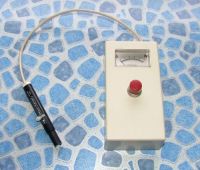|
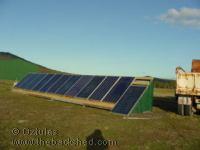
|
| Make your own Solar Panels! |
Page 1 | 2 | 3 | 4 | 5 |
 Back to Page 2. Back to Page 2.
I bought the EVA from here: http://www.aliexpress.com/product-gs/317352087-Solar-EVA-Film-wholesalers.html
They got it here pronto, and free shipping. Minimum order is 10 meters with free shipping to even here (remote island).
The base EVA material is combined with additives via catalysts with added curing agents, UV stabilizers, anti-oxidants etc. Also glass primers to aid adhesion to the glass substrate.
Note we said curing agent. This tells us that we start with one material, and it CURES into another. Thats the crosslinking we talk about. We are not just melting and resetting, otherwise we would not need to hold it at certain temps for certain periods of time... We are melting, and holding it in that state, while the gell changes it's characteristics.
If we were to take samples during the curing, we could weigh them, wash the uncured gell out with hot toluene solvent, and weigh again.
What is left to weigh is the final material, the toluene will disolve out the uncured gell. We could use this technique to see if we had finalised the curing or not in a scientific way if we so chose..... or we could use differential scanning calorimetry to acsertain the remaining gell content..... or just have a look and see if it has stuck to the glass yet....just keep testing until you get the ball park timing right.... simple stuff indeed.
One thing that does not sit right with me is some comments made that the cells only get as warm as they would in open circuit condition.... ie don't heat up under load, but in fact should cool by the amount of energy they transport from the cell to the load.... sounds right..... but in a panel.....
I have not found that to be the case. In all instances I have tried, commercial and home brew, there will be some cells in the matrix that get very very hot, and those that don't.
Those hot cells will certainly cure the EVA around them if it was not fully cured before. I assume that as all cells are not created equal, different resistance cells will handle the current differently. Those with the highest resistance will get hottest, and so get hotter as they get thermal runaway (ish), and they end up very hot indeed. ...... but I have never seen any sign of remelt in those instances..... even in the home brew ones.
Well it's time to ramp it up a bit. Up until now I have attempted to show how simple it is to work with the EVA, and make a single cell panel with very little tools at all..... yes even with a cardboard oven etc.
Time to build a new 250watt panel, so I tried to photograph it as I went..... but forgot to use the camera as much as I would have liked. You just forget that people may not know how to do some things that I take for granted, and so gloss over it.... eg how to build a 2.5m*2m plastic bag at a moments notice etc.
I will take it as read that we know how to tab cells, (youtube does this well). Once tabbed we are ready to begin..... first we need the glass.
In this case we will be using the iron free solar glass from a disused solar hot water panel. It is toughened, and the iron free...... this means when you should get 1.8w per cell you will. If you use window glass, then it will be less, but work anyway.
So we get the glass and wash it in water and dry thoroughly. Then wash the cell side with methylated spirits and dry. My glass has prisms on one side and flat on the other.... like frosted shower glass almost.... I have tried bot the rough side and the smooth side to put the cells on..... I think I prefer the smooth side and get a rough outside..... slightly better when the light is diffuse....... however, in latitudes where the panels are flatter, then cleaning becomes a problem where the dust settles in the rough valleys.... so in those latitudes, perhaps put the cells on the rough side with the smooth side to the sun.... your choice really.
My glass looked like this: I won't attempt to detail the cell joining process as it is just soldering cells together, and this too, is covered well elsewhere. Suffice to say, keep as much room between cells as your design and glass size can afford... I like 1/4 inch, but rarely get that luxury. In this case I need 23 cells in a single string to fit in the glass with an inch left at each end. This dictates very close spacing between cells, and can lead to shorts if not careful. |
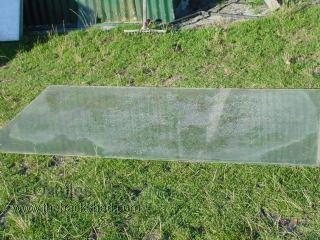 |
I also use the solar hot water case as a straight edge to build the string in. I use transformer paper on top of the aluminium (to stop the Al draining the heat from the cell too fast when soldering), and use the side of the case as the straight edge. This way guarantees that the cells don't wander about the place.
It looks like this: |
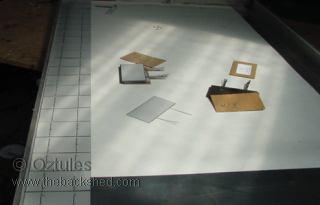 |
We then carefully (very) pick it up and transfer it to the glass sheet which has the EVA cut to size on it I use some untabbed cells to get the spacial arrangement to make it look symmetrical …...not very well really, but I did try a little bit.
|
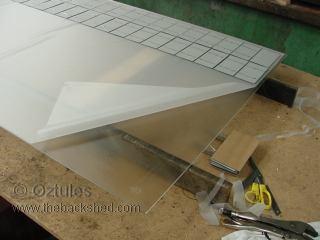 |
| We keep labouring away until we fill the glass up with cell strings. We then need to place the bus lines in to join the strings. There was not a lot of room to do this here, so I actually placed the output tabs on top of the last cells in the string in some places. I use transformer paper to effect the isolation needed, and EVA strips between any surfaces, so that the whole lot will melt together later. It may be seen here: |
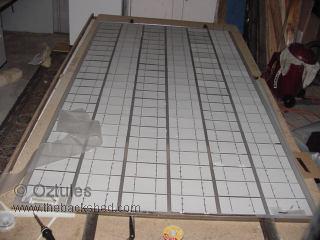 |
From a "looks" point of view, it is more important to get the strings straight, and the gap between strings even. The inter cell gaps in a single string seem to have little impact visually compared to these other two requirements. I see a lot of youtube folks with tile spacers to try to get it right, and they still fail miserably.... so just keep the lines straight, and even between strings and it will look ok. .... I think anyway.
Then it's time to place your second sheet of EVA on the pile. Hopefully you remember to cut it before we get to this point.... unlike me. |
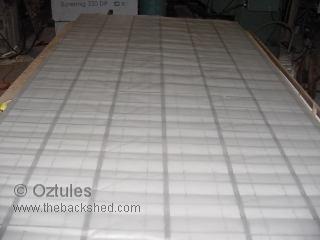 |
Then it's time for the backing material (building wrap this time for me, later I will use plastic sheet (ran out of the white stuff), and whatever else for you). |
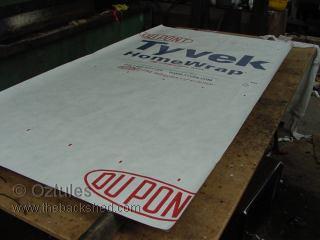 |
Page 4  |

